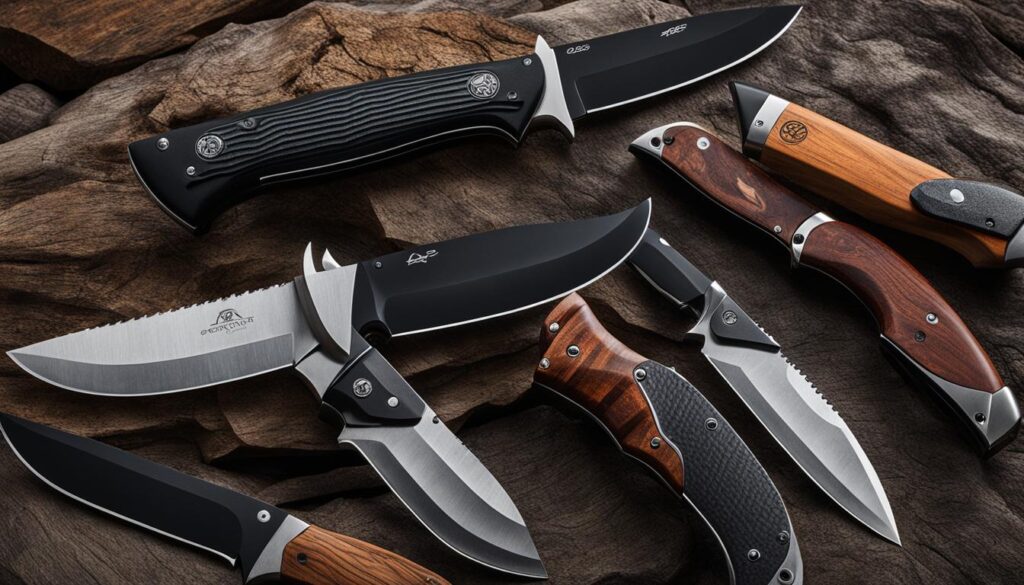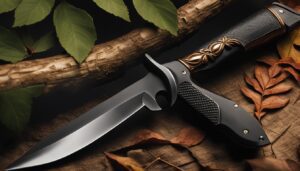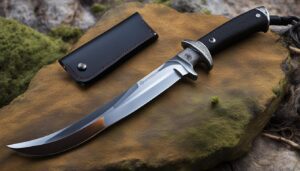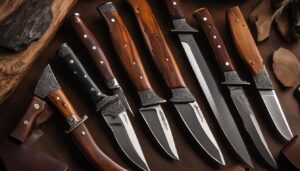As an outdoor enthusiast, I understand the importance of having the right tools for your hunting expeditions. One crucial tool that every hunter needs is a high-quality skinning hunting knife. Whether you are an experienced hunter or a beginner, a reliable hunting knife is essential for tasks like skinning, cutting, and even self-defense. In this guide, we will explore the factors to consider when choosing a hunting knife, the different types available for various outdoor activities, maintenance and care tips, as well as further opportunities for skill development and exploration in the knife community.
Key Takeaways:
- Choosing the right skinning hunting knife is crucial for outdoor enthusiasts.
- Consider factors like blade shape, steel type, handle design, tang, and sheath when selecting a hunting knife.
- There are different types of hunting knives designed for specific outdoor activities.
- Maintaining and caring for your hunting knife ensures its longevity and optimal performance.
- Exploring knife skills workshops and outdoor survival courses can enhance your outdoor experience.
Criteria for Choosing the Right Hunting Knife
When it comes to selecting the perfect hunting knife, there are several important criteria to consider. Each aspect of the knife plays a crucial role in its performance and suitability for various outdoor activities. By understanding these criteria, you can make an informed decision and choose a hunting knife that meets your specific needs.
Blade Shape
The blade shape is a fundamental factor to consider when selecting a hunting knife. The two popular choices are the clip-point and drop-point shapes. The clip-point blade features a concave curve leading to a fine, sharp point, making it ideal for precision tasks such as skinning. On the other hand, the drop-point blade has a convex curve that provides durability and versatility, making it suitable for a wide range of tasks like cutting and slicing.
Steel Type
The type of steel used in the blade is crucial for determining its durability, corrosion resistance, and ability to hold an edge. High-quality stainless steel, such as VG10 or S30V, offers excellent corrosion resistance and edge retention. Carbon steel blades, like 1095 or D2, are known for their exceptional edge sharpness but require regular maintenance to prevent rust. Consider your specific needs regarding edge retention and maintenance when choosing the steel type for your hunting knife.
Handle Design
The handle design plays a vital role in the knife’s comfort and grip. Look for a handle that offers a secure grip, even in wet or cold conditions. Durable materials like G10, Micarta, or textured rubber provide excellent grip and durability. Ergonomic designs with finger grooves or textured patterns enhance comfort and control during use, reducing the risk of accidents.
Tang and Sheath
The tang refers to the portion of the blade that extends into the handle. A full tang, where the blade extends the entire length of the handle, offers excellent strength and durability. Partial tangs are suitable for lighter tasks but may not withstand heavy use. Additionally, choose a hunting knife with a reliable sheath that securely holds the knife while providing easy access and safe transportation.
| Criteria | Description |
|---|---|
| Blade Shape | Consider clip-point or drop-point shapes for different tasks. |
| Steel Type | Choose high-quality stainless steel or carbon steel based on edge retention and maintenance requirements. |
| Handle Design | Look for a handle that offers a secure grip and durability. |
| Tang and Sheath | Opt for a full tang for strength and durability and ensure the sheath securely holds the knife. |
Types of Hunting Knives for Different Outdoor Activities
When it comes to outdoor activities, having the right hunting knife can make all the difference. There are various types of hunting knives designed to cater to specific needs and tasks. Let’s explore some of the popular hunting knife types:
1. Skinning Hunting Knife
The skinning hunting knife is specifically designed for efficiently skinning and field dressing game. These knives have sharp blades with curved edges, allowing hunters to easily remove the skin from the animal without damaging the meat.
2. Survival Knife
A survival knife is a versatile tool that serves multiple purposes in the outdoors. It is designed to handle tasks like cutting firewood, building shelters, and even self-defense. These knives are generally sturdy and durable to withstand rugged conditions.
3. Folding Knife
A folding knife is a compact and portable option that is suitable for everyday use and light outdoor tasks. It features a folding mechanism that allows the blade to be safely tucked inside the handle, making it convenient to carry and store.
4. EDC Knife
An EDC (Everyday Carry) knife is a lightweight and versatile option that can be used for various tasks in everyday life as well as basic outdoor needs. These knives are designed to be easily carried in pockets or worn on belts, ensuring accessibility at all times.
5. Multi-Tool Knife
A multi-tool knife combines a knife with other essential tools, such as pliers, screwdrivers, and bottle openers, all in one compact package. This type of knife is perfect for outdoor enthusiasts who value convenience and functionality.
6. Fishing Knife
For anglers, a fishing knife is a must-have tool. Specifically, a fillet knife is designed to clean, fillet, and prepare fish. These knives have flexible blades that make it easier to navigate around the bones and get precise cuts.
Each type of hunting knife has its own advantages and specific uses. Consider your outdoor activities and the tasks you’re most likely to encounter when choosing the right hunting knife for your needs.
Maintenance and Care Tips for Hunting Knives
Proper maintenance and care are essential for ensuring the longevity and optimal performance of your hunting knife. By following a few simple steps, you can keep your knife in top shape for all your outdoor adventures. Here are some tips to help you maintain and care for your hunting knife:
Cleaning:
Regularly clean your hunting knife to remove dirt, debris, and moisture. Use mild soap and water to clean the blade, handle, and any other parts of the knife. Pay special attention to drying the knife thoroughly to prevent rust and corrosion. Avoid using harsh chemicals or abrasive materials that can damage the knife’s finish.
Sharpening:
Keeping your hunting knife sharp is crucial for its effectiveness. Use a sharpening stone or a knife sharpener specifically designed for your type of blade to maintain a sharp edge. Follow the manufacturer’s instructions and take your time to ensure a proper sharpening angle. Remember to regularly inspect the blade for any nicks or damage that may require professional sharpening.
Lubricating and Storing:
Proper lubrication and storage are important for preventing rust and maintaining smooth operation. Apply a high-quality knife lubricant or oil to the pivot areas and locking mechanisms of folding knives. This will help keep the moving parts functioning properly. When storing your hunting knife, make sure it is clean and dry. Store it in a sheath, a dedicated knife pouch, or a dry environment to protect it from moisture and damage.
Regularly inspect your hunting knife for any signs of wear, damage, or rust. Check the blade, handle, and any locking mechanisms for any issues that may affect the knife’s performance. If you notice any problems, address them promptly. Minor maintenance and repairs can prevent further damage and extend the lifespan of your hunting knife.
Further Exploration and Development in Knife Skills and Outdoor Activities
To enhance your knife skills and overall outdoor experience, there are several avenues to explore. Participating in knife skills workshops or classes can provide valuable hands-on training and guidance. These workshops often cover topics such as proper knife handling techniques, blade sharpening, and knife maintenance. They offer an opportunity to learn from experienced instructors and improve your skills in a supportive environment.
Another option is to enroll in outdoor survival courses. These courses go beyond knife skills and teach you essential techniques for wilderness survival. From building shelters and finding food to navigation and first aid, these courses provide a comprehensive education on surviving in the great outdoors. They often incorporate knife skills as a fundamental part of the curriculum.
Connecting with the knife community is another way to expand your knowledge and skillset. Online forums and social media groups dedicated to knives and outdoor activities can be a wealth of information. You can engage in discussions, ask questions, and learn from seasoned enthusiasts. It’s also a great way to discover new knife techniques, trends, and products.
If you’re looking to personalize your knife, knife customization is an exciting option. Many knife makers offer customization services, allowing you to choose specific handle materials, blade finishes, and even engraving options. Customizing your knife not only adds a personal touch but also ensures that it meets your specific preferences and needs.
Table: Benefits of Further Exploration in Knife Skills and Outdoor Activities
| Benefits | Description |
|---|---|
| Improved Skills | Enhance your knife skills through workshops and courses. |
| Survival Knowledge | Learn essential outdoor survival techniques. |
| Community Engagement | Connect with like-minded individuals in the knife community. |
| Personalization | Customize your knife to fit your preferences and style. |

Expanding your knife collection is also an exciting avenue for further exploration. Different knives serve different purposes, and building a diverse collection allows you to have the right tool for various tasks. From hunting and fishing to camping and everyday carry, there is a knife designed for every activity. Exploring different blade types, handle materials, and locking mechanisms can give you a deeper understanding of the art and functionality of knives.
In summary, there are numerous ways to further develop your knife skills and outdoor activities. Whether it’s through workshops, courses, engaging with the knife community, customizing your knife, or expanding your collection, each avenue offers unique benefits and experiences. Take the opportunity to explore and grow in your passion for knives and outdoor pursuits.
Overview of Top Hunting Knife Brands and Selection Considerations
When it comes to choosing a hunting knife, there are several top brands that consistently deliver quality and reliability. These brands include Benchmade, Buck, Kershaw, Gerber, and Spyderco. Each brand has its own unique features and strengths, making it important to consider your specific needs and preferences when making a selection.
Benchmade is known for its precision craftsmanship and innovative designs. They offer a wide range of hunting knives with high-quality steel blades and durable handles. Their knives are designed to withstand the toughest outdoor conditions.
Buck is a well-established brand that has been trusted by hunters for generations. They are known for their traditional designs and attention to detail. Buck knives are made with high-grade materials and are built to last.
Kershaw is known for its affordable yet high-quality hunting knives. They offer a wide selection of blades, from fixed to folding, with various handle materials. Kershaw knives are known for their sharpness and durability.
Gerber is a brand known for its versatility and reliability. They offer a range of hunting knives for different purposes, including skinning, gutting, and field dressing. Gerber knives are designed to be durable and easy to use.
Spyderco is a brand that focuses on innovation and functionality. They are known for their unique blade designs and ergonomic handles. Spyderco knives are highly regarded for their cutting performance and quality construction.
When choosing a hunting knife brand, it’s important to consider factors such as the sharpness of the blade, the quality of the steel used, the comfort and security of the handle, and the appropriateness of the blade shape for your specific needs. Additionally, consider factors such as the size and weight of the knife, the materials used in the handle, and your budget. Investing in a high-quality hunting knife from a reputable brand will ensure longevity, reliability, and optimal performance.


| Brand | Strengths |
|---|---|
| Benchmade | Precision craftsmanship and innovative designs. High-quality steel blades and durable handles. |
| Buck | Traditional designs with attention to detail. High-grade materials and durability. |
| Kershaw | Affordable yet high-quality knives. Sharpness and durability. |
| Gerber | Versatility and reliability. Range of knives for different purposes. |
| Spyderco | Innovation and functionality. Unique blade designs and ergonomic handles. |
Conclusion
Choosing the best hunting knife is a crucial decision for any outdoor enthusiast. To make an informed choice, consider several factors that can greatly influence your knife’s performance and durability. The blade shape, steel type, handle design, tang, and sheath are all important aspects to take into account.
By carefully evaluating these factors, you can ensure that your hunting knife meets your specific needs and requirements. Whether you prefer a clip-point or drop-point blade shape, a stainless steel or carbon steel blade, or a full tang or partial tang design, each choice will impact the knife’s performance in different ways.
In addition, proper maintenance and care are essential for keeping your hunting knife in top condition. Regular cleaning, sharpening, lubricating, and inspecting will help maximize its lifespan and ensure consistent performance. By taking the time to maintain your knife, you can rely on it during your outdoor adventures for years to come.
So, when choosing the best hunting knife, remember to weigh your options carefully and consider the factors that matter most to you. With the right selection and proper maintenance, your hunting knife will be a reliable companion on all your outdoor escapades, providing you with the functionality, performance, and durability you need.
FAQ
What factors should I consider when choosing a hunting knife?
When choosing a hunting knife, consider factors such as blade shape, steel type, handle design, tang, and sheath.
What are the different types of hunting knives available?
There are various types of hunting knives, including skinning hunting knives, survival knives, folding knives, EDC knives, multi-tool knives, and fishing knives.
How should I maintain and care for my hunting knife?
Proper maintenance and care include regularly cleaning the knife, sharpening the blade, lubricating folding knives, and storing them in a dry and cool environment.
How can I enhance my knife skills and outdoor experience?
You can consider participating in knife skills workshops or classes, outdoor survival courses, connecting with the knife community, and exploring knife customization.
Which are some top hunting knife brands, and what should I consider when selecting a brand?
Some top hunting knife brands include Benchmade, Buck, Kershaw, Gerber, and Spyderco. When selecting a brand, prioritize factors such as sharpness, high-quality steel, handle comfort, and appropriate blade shape.





